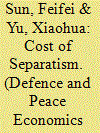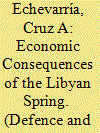|
|
|
Sort Order |
|
|
|
Items / Page
|
|
|
|
|
|
|
| Srl | Item |
| 1 |
ID:
186453


|
|
|
|
|
| Summary/Abstract |
There is increasing scientific evidence of anthropic climate change. The need to shift to more sustainable energy systems is therefore compelling. Individuals are becoming key actors in the energy transition, as producers and sellers of the renewable energy they produce on-site. However, the practice of self-consumption requires to be underpinned by adequate policy mechanisms. Under this perspective, the Spanish Royal Decree (RD) 900/2015, also so-called “Tax on the Sun”, aiming at regulating energy self-consumption and enhancing the engagement of Spanish citizens in the energy transition as prosumers, by the installation of photovoltaics, represents a challenging case study. There is anecdotal evidence that instead of supporting the diffusion of electricity self-consumption, the “Tax on the Sun” has had the opposite effect. Thus, this work aims at testing this proposition by using the synthetic control methodology (SCM), which permits to evaluate the effect of a treatment in absence of a suitable control group, as in this case. This study finds that indeed at the regional level the “Tax on the Sun” has had a negative impact, if any at all. The current barriers to prosumerism, and more broadly to the active involvement of citizens in the energy transition, are still many and policy-makers should address these shortcomings if they want to fully employ the potential that prosumerism has to offer to a just energy transition.
|
|
|
|
|
|
|
|
|
|
|
|
|
|
|
|
| 2 |
ID:
171064


|
|
|
|
|
| Summary/Abstract |
The separatism and its related activities bring enormous economic costs to a society, which is however difficult to be estimated, because it involves both observable ethnic conflicts and unobservable psychological resistance. This paper investigates the economic consequences of the 1987–89 Tibetan Unrests with the synthetic control method and finds that per capita GDP in Tibet might be 27% higher for the period from 1988 to 2007 if the unrests had not happened. In addition, we implement several ‘placebo studies’ and assess the threats to the validity of causal inference to confirm the robustness of this study.
|
|
|
|
|
|
|
|
|
|
|
|
|
|
|
|
| 3 |
ID:
167863


|
|
|
|
|
| Summary/Abstract |
In 2011 a wave of revolutionary movements, the so-called Arab Spring, spread in the Middle East and North Africa. Libya was one of the most affected countries, ending Gaddafi’s dictatorship after an international intervention and a civil war. This paper assesses the effects that this revolution had on Libyan economy. The analysis is made by means of the synthetic control method. Our estimates for the 2011–2014 period show (i) a cumulative loss in the growth rate of per capita real GDP of 64.15%; (ii) a cumulative loss in per capita real GDP of 56,548 dollars; and (iii) a cumulative loss in the aggregate real GDP of 350.5 billion dollars.
|
|
|
|
|
|
|
|
|
|
|
|
|
|
|
|
| 4 |
ID:
184051


|
|
|
|
|
| Summary/Abstract |
This study estimates the joint effect of a new political regime and war against Iraq, on Iran’s per capita Gross Domestic Product (‘GDP,’ constant 2010 US$) for the period 1978–1988, during the revolution/war. I use a synthetic control approach, whereby a synthetic Iran is constructed as a weighted average of other Middle East and North Africa (‘MENA’)/Organization of the Petroleum Exporting (‘OPEC’) countries to match the average level of some key per capita GDP correlates over the period 1970–1977 as well as the evolution of the actual Iranian per capita GDP during that period. I find a sizable negative effect of the joint treatment. The average Iranian lost an accumulated sum of approximately US$ 34,660 during 1978–1988 (i.e. the average annual real per capita income loss of US$ 3,150). This loss equals 40% of the real income per capita, which an Iranian could earn in the absence of revolution and war. The confidence sets based on constant, linear, and uniform assumptions of treatment effect show that estimated income loss for Iran is sizeable and statistically significant. The results remain robust to a set of placebo tests.
|
|
|
|
|
|
|
|
|
|
|
|
|
|
|
|
| 5 |
ID:
186522


|
|
|
|
|
| Summary/Abstract |
Due to the pro-independence demands of part of its electorate, the political fit of Catalonia within Spain has given rise to notable political tensions over the last few years. This conflict has progressively affected several dimensions of Catalan society, including, potentially, the economy. The illegal referendum on independence, held in October 2017, marked the climax of political and social tensions, leading to a Constitutional crisis and further stoking the conflict as opposed to offering any hope of an early resolution. We analyze a complete set of margins potentially affected by the referendum, including real (aggregate demand and supply) and financial responses. Using a synthetic control method, we find strong evidence of the outflow of short-term bank deposits after the referendum; while, on the real side, we find evidence of responses in aggregate supply (number of capital increases and number of new firms registered).
|
|
|
|
|
|
|
|
|
|
|
|
|
|
|
|
| 6 |
ID:
151117


|
|
|
|
|
| Summary/Abstract |
There is a consensus that civil wars entail enormous economic costs, but there is little systematic analysis of the determinants of their heterogeneous destructiveness. Moreover, reliably estimating these costs has proven challenging, due to the complexity of the relationship between violence and socio-economic conditions. In this article, we study the effect of ethnic fractionalization of war-torn countries on the economic consequences of civil war. Building on an emerging literature on the relationships between ethnicity, trust, economic outcomes, and conflict processes, we argue that civil wars erode interethnic trust and highly fractionalized societies pay an especially high price, as they rely heavily on interethnic business relations. We use the synthetic control method to construct appropriate counterfactuals and measure the economic impact of civil war. Our focus is on the years of armed conflict in a sample of 20 countries for which we observe an average annual loss of local GDP per capita of 17.5%, though with remarkable variation across cases. The empirical analysis provides supporting evidence in the form of a robust positive association between ethnic fractionalization and our measures of war-induced economic costs.
|
|
|
|
|
|
|
|
|
|
|
|
|
|
|
|
| 7 |
ID:
177311


|
|
|
|
|
| Summary/Abstract |
Since 1994, to overcome adoption barriers and promote new energy vehicles (NEVs), eight cities and one province in China have implemented a license plate quota policy for internal combustion engine vehicles (ICEVs). We use a city-level dataset of NEV sales to assess the impact of license plate quota policy for ICEVs on the adoption of NEVs, by using both the synthetic control method (SCM) and difference-in-differences (DID) method for the first time. We find that license plate quota policy can significantly increase the annual sales of NEVs in Tianjin, Hangzhou, Shenzhen, and Haikou by approximately 73.4%, 87.5%, 87%, and 65.5% of total sales of NEVs, which is equivalent to increasing the annual sales of NEVs by 15,557, 22,267, 37,455, and 448 vehicles, respectively. Further, our findings indicate that a license plate quota policy for ICEVs promotes the adoption of NEVs but has certain limitations, for example, license plate quota policy has a short-term inhibitory effect on the regional auto industry. Moreover, due to the restraint on consumers from purchasing ICEVs, consumers have certain negative sentiment toward the policy based on text analysis. Regions where license plate quota policy is adopted generally required well-developed public transportation and adequate charging infrastructures.
|
|
|
|
|
|
|
|
|
|
|
|
|
|
|
|
| 8 |
ID:
180148


|
|
|
|
|
| Summary/Abstract |
To stabilize the global CO2 concentration in the long run and secure a net zero emission development path, low-carbon innovation is imperative. This paper evaluates the impact of emission trading schemes on low-carbon innovation. Particularly, we focus on the seven emission trading pilots in China. They employed diversified scheme designs, and reaping heterogeneous low-carbon innovation effects. The empirical results show that 1) low-carbon innovation in the three pilots of Beijing, Shanghai, and Guangdong responds more to the national demand for green technological changes, rather than to local policy shocks; 2) the Hubei pilot is the only successful one in raising low-carbon innovation motivations. Its success may be related to distinctive features of the market, including active transaction of carbon allowances, ambitious utilization of the auction mechanism in initial allowance allocation, and focus of regulation capacities on the most influential emitting entities. These features should be deliberately utilized in design the national carbon market, which has been pronounced at the end of 2017. Our research highlights the importance of detailed mechanism design for securing dynamic effectiveness of carbon emission trading schemes.
|
|
|
|
|
|
|
|
|
|
|
|
|
|
|
|
| 9 |
ID:
176121


|
|
|
|
|
| Summary/Abstract |
The green development of free trade zones conforms to the theoretical principles of sustainable development and is key to promoting regional transformation and upgrading. By using synthetic control methods (SCM) based on microscopic data, this paper investigates the net effect of the establishment of the China (Shanghai) pilot free trade zone (SPFTZ) on green total factor productivity (GTFP) in Shanghai. The results show that the SPFTZ has promoted the GTFP in Shanghai. As far as time trend is concerned, the effects of this promotion become more apparent after a short-term period of slow growth. In terms of impact paths, the main driving force of policy is technological progress. Therefore, the SPFTZ should improve GTFP and create greater incentives for technological innovation. Institutional innovation for green development should play a central guiding role in the construction. We need continue to explore other green development models as well as means of creating higher levels of economic openness.
|
|
|
|
|
|
|
|
|
|
|
|
|
|
|
|
| 10 |
ID:
188158


|
|
|
|
|
| Summary/Abstract |
This paper focuses on the Shanghai pilot free trade zone (FTZ). It investigates the effect of the FTZ policy on regional financial development. The synthetic control method employs quarterly data from 2005 to 2019 at the provincial level to investigate counterfactual states before and after the pilot FTZ was set up. First, our results reveal that the Shanghai pilot FTZ had a positive influence on the following four variables proxied for regional financial development: (i) the scale of regional financial development; (ii) the efficiency of indirect financial development; (iii) the efficiency of direct financial development; (iv) the structure of financial development. Second, our results found that the policy effects that began to emerge from 2014 onwards exhibited a steadily increasing trend. As a result, the four proxy variables have increased by (i) 197 percent, (ii) 202 percent, (iii) 9.4 percent, and (iv) 15.2 percent, respectively. That is, the scale of regional financial development and the efficiency of indirect financial development have increased more than the other proxy variables.
|
|
|
|
|
|
|
|
|
|
|
|
|
|
|
|
| 11 |
ID:
187848


|
|
|
|
|
| Summary/Abstract |
Understanding the carbon implications of mega sporting events (MSEs) is critical for the hosting country or city, if they are to tackle climate change challenges. Taking the case of the 2014 Nanjing Youth Olympics (NYO), this study examines the impacts on the host's local carbon emissions during the ‘preparatory-hosting-after’ stages of a MSE. By adopting a synthetic control method (SCM) and logarithmic mean divisia index (LMDI) decomposition, the following findings are reached: (1) From 2010, when the city of Nanjing announced the decision to bid to host the NYO, the NYO increased the carbon emissions of Jiangsu (the province to which Nanjing belongs) in every year from 2010 to 2019. The total increase in the emissions caused by the NYO was approximately 584.63 million tons. That figure is 1.65 times the total carbon emissions of the United Kingdom in 2018. (2) The annual amount of increased emissions also rose during the preparatory and post stages of the NYO, but the amount of increased emissions during the hosting year was relatively lower, at 53.36 million tons. (3) The NYO improved the energy intensity of the industrial sector, and thereby partially decreased local carbon emissions. Conversely, the NYO induced continuous impacts on local per capita output, the energy intensity of the transportation sector, the scale and energy structure of the industrial sector, and thus promoted emissions, even after the games.
|
|
|
|
|
|
|
|
|
|
|
|
|
|
|
|
| 12 |
ID:
190433


|
|
|
|
|
| Summary/Abstract |
We examine the long-term effects of civil war in former Yugoslavia on economic growth and development. To this end, we employ the synthetic control methodology, and estimate the missing counterfactual scenario for the long-run growth and development of former Yugoslav republics, in the absence of the civil war by matching their growth and development characteristics with non-Yugoslav countries at the similar stages of development. The results suggest that the civil war led to unprecedented long-run growth and development losses. In the absence of the war, per capita income levels of former Yugoslav republics would improve markedly with notable differences in the magnitude of the growth and development gains across the affected countries. The estimated effects of the civil war are robust to a large number of placebo checks, and falsification-based random permutation tests. The results show that not a single former Yugoslav republic down to the present day has achieved the level of per capita income predicted by their synthetic control groups in the years preceding the civil war. Our results show that the Yugoslav civil war appears to be a permanent institutional shock with long-lasting implications for economic growth and development.
|
|
|
|
|
|
|
|
|
|
|
|
|
|
|
|
| 13 |
ID:
182680


|
|
|
|
|
| Summary/Abstract |
This article contributes to both the theoretical elaboration and empirical testing of the ‘stability–instability paradox’, the proposition that while nuclear weapons deter nuclear war, they also increase conventional conflict among nuclear-armed states. Some recent research has found support for the paradox, but quantitative studies tend to pool all international dyads while qualitative and theoretical studies focus almost exclusively on the USA–USSR and India–Pakistan dyads. This article argues that existing empirical tests lack clearly relevant counterfactual cases, and are vulnerable to a number of inferential problems, including selection on the dependent variable, unintentionally biased inference, and extrapolation from irrelevant cases. The limited evidentiary base coincides with a lack of consideration of the theoretical conditions under which the paradox might apply. To address these issues this article theorizes some scope conditions for the paradox. It then applies synthetic control, a quantitative method for valid comparison when appropriate counterfactual cases are lacking, to model international conflict between India–Pakistan, China–India, and North Korea–USA, before and after nuclearization. The article finds only limited support for the paradox when considered as a general theory, or within the theorized scope conditions based on the balance of resolve and power within each dyad.
|
|
|
|
|
|
|
|
|
|
|
|
|
|
|
|
|
|
|
|
|